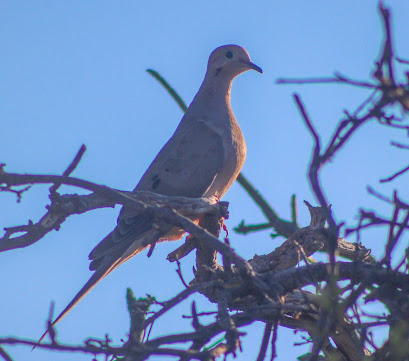Our son, Sam, has an interest in trees and recently said he would love to see the northern California redwoods and the sequoias in Central California. So we planned a trip where Judy and I drove to Redding and met Sam at the airport there, then drove northwest to the California coast and ultimately up to Crescent City, near the California/Oregon border, then back down Hwy 101 to near San Francisco, before veering off into Central California to visit Kings Canyon and Sequoia National Parks.
We saw some beautiful country. In this post I'm going to highlight the redwood areas we visited, but first a little on the coast redwood. It includes the tallest living trees on earth, up to 379 feet high and 29 feet in diameter at (human) breast height. They can live 1,200 to 1,800 years and even longer. It has a conical crown and horizontal to slightly drooping branches. The bark can be up to a foot thick with a bright red-brown color when first exposed (thus the name), then weathering darker. The leaves vary. On young trees and shaded lower branches of older trees, the leaves are long and flat. In the upper crown of older trees they are scale-like. They are dark green above and have two blue-white stomatal bands below. They occupy a strip of land along the Pacific coast that is 470 miles long and 5 to 47 miles wide. The most northerly grove is in extreme southwest Oregon (in Alfred A. Loeb State Park in the Siskiyou National Forest) and the most southerly grove is in Monterey County, California (the Southern Redwood Botanical Area just north of the Salmon Creek Trailhead near the San Luis Obispo County line). The largest and tallest populations are in Redwoods National and State Parks and Humboldt Redwoods State Park.
According to Wikipedia, the tallest tree in the world is the Hyperion Tree which is 379.3 feet tall in Redwood National Park. The exact location is a secret to keep it safe. The fifth tallest tree in the world is one I believe we saw, the National Geographic Tree, in Redwood National Park, 369.8 feet tall, 14.4 feet in diameter, trailside in the Tall Trees Grove (see below). It is the most accessible of the tallest trees.
Our first contact with the coast redwood was near Trillium Falls in Prairie Creek Redwoods State Park. About 2 miles north of Orick on Hwy 1 we turned left on Davison Road, then in .4 miles just past Elk Meadow we turned left and went a short distance to a parking area for the trailhead. The hike to Trillium Falls is short, but gorgeous. As we saw our first coast redwoods both Sam and Judy exclaimed that this, alone, was worth the trip. They are difficult to photograph because they are so large and you can't get back for a distance for photos because the forest growth is so dense. So my typical photos were taken near the trunk and staring up into the tall leafed branches. The photo below is one (or two or three or four) of many we saw.

Four miles north of Davison Road, to the left of Hwy 101, still in Prairie Creek Redwoods State Park, we took the 10 mile long Newton B. Drury Redwood Scenic Parkway, which is stunning. One mile north of the visitor center is the Big Tree trail. It is an area of stunning coast redwoods with Big Tree, 286 feet tall and 23.7 feet in diameter, as the star.
 |
The light and the photo opportunities at the Big Tree were not great, but this is a photo of a different coast redwood.
|
My favorite of our redwood sightings was the Stout Grove in Jedediah Smith Redwood State Park northeast of Crescent City, near Hiouchi. It has a .5 mile circular trail through extremely impressive coast redwoods. The following are my favorite photos from that grove.
 |
| This was my favorite spot, at the bottom of these trees, looking up. |











Next we visited
Tall Trees Grove in Redwoods National Park. We had to get a permit in advance and the combination to a locked gate. Only 50 people a day are allowed to visit. It is a 6 mile drive up Bald Hills Road to the locked gate, then another 6 mile drive on a dirt road to the trailhead, then a 4 mile roundtrip hike to the grove.
The grove is on a thin strip of flat land about a quarter mile long, alongside Redwood Creek. What Wikipedia refers to as the National Geographic Tree gets that name because it was on the cover of the 1964 issue of National Geographic. It is also called the Howard Libbey Tree, at that time considered the tallest tree in the world. According to the website I've linked at the beginning of this paragraph, the Hyperion Tree, the current tallest tree in the world, discovered later, is just a half mile away, up Tom McDonald Creek (which empties into Redwood Creek). The trees in this grove are not marked and I don't believe we actually saw the National Geographic Tree because it is about 30 feet behind a wood fence, among other trees, and is not marked. From the vantage point of the trail, there is no way to determine what tree is taller than another.





Our last redwoods visit was the Avenue of the Giants 32 mile auto tour which is in Humboldt Redwoods State Park, between Phillipsville and Pepperwood. We just stumbled upon it, we were not aware of it in advance. So we did not have any particular spot we knew of to stop at and drove it casually. It was beautiful with lots of redwoods.





















































